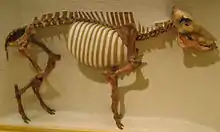Platygonus
Platygonus ("flat head" in reference to the straight shape of the forehead)[1] is an extinct genus of herbivorous peccaries of the family Tayassuidae, endemic to North and South America from the Miocene through Pleistocene epochs (10.3 million to 11,000 years ago), existing for about 10.289 million years .[2]
| Platygonus | |
|---|---|
 | |
| Platygonus compressus skeleton at Harvard University | |
| Scientific classification | |
| Kingdom: | Animalia |
| Phylum: | Chordata |
| Class: | Mammalia |
| Order: | Artiodactyla |
| Family: | Tayassuidae |
| Genus: | †Platygonus LeConte 1848 |
| Type species | |
| Platygonus compressus LeConte 1848 | |
| Species | |
|
See text | |
| Synonyms | |
Description

Platygonus were gregarious animals and, like modern peccaries, possibly traveled in herds. At least nine known species of Platygonus are known and ranged from southern Canada to Mexico and from California to Pennsylvania. Stratigraphically, they occur throughout the Pleistocene (Calabrian), and as early as the Blancan in the Gelasian of the Pliocene. The most recent credible date obtained for some species remains is about 11,000 BP.[3] They probably appeared very similar to their closest living relative, the Chacoan peccary.
Taxonomy

Platygonus was named by John Lawrence LeConte in 1848 for fossils found in Pleistocene karst deposits in Illinois, which are now preserved in the Academy of National Sciences in Philadelphia.
The following species of Platygonus have been described:[2]
- P. bicalcaratus (nomen dubium)
- P. brachirostris
- P. chapadmalensis
- P. cinctus
- P. compressus (type)
- P. kraglievichi
- P. marplatensis
- P. narinoensis
- P. oregonensis
- P. pearcei
- P. pollenae
- P. scagliae
- P. setiger
- P. striatus
- P. texanus
- P. vetus
Morphology
Most Platygonus species were similar in size to modern peccaries especially giant peccary, at around 1 m (3.3 ft) in body length, and had long legs, allowing them to run well. They also had a pig-like snout and long tusks which were probably used to fend off predators.[4] They had a complex digestive system, similar to that of a modern ruminant.
Distribution
Fossils of Platygonus have been found in:[2]
- Miocene
- Chapadmalalan
- Chapadmalal Formation, Argentina
- Hemphillian
- Beecher Island, Colorado
- Edson Beds, Kansas
- Rancho Viejo Beds, Mexico
- Devil's Nest Airstrip, Ogallala Group, Nebraska
- McKay and Rattlesnake Formations, Oregon
- Miami Quarry, Texas
- Blancan
- Gila Conglomerate and St. David Formation, Arizona
- Palm Spring and San Diego Formations, California
- Tamiami Formation, Florida
- Glenns Ferry Formations, Idaho
- Ballard, Rexroad and Crooked Creek Formations, Kansas
- Rancho Viejo Beds, Mexico
- Tequixquiac, Mexico
- Panaca Formation, Nevada
- Camp Rice Formation, New Mexico
- Blanco and Love Formations, Texas
- Ringold Formation, Washington
- Plio-Pleistocene
- Pleistocene
- Tarija Formation, Bolivia
- Palm Spring and Turlock Lake Formations, California
- Bermont and Wicomico Formations, Florida
- Yarbrough Cave, Georgia
- American Falls Lake Bed E Formation, Idaho
- Galena, Illinois (type locality)[6]
- Harrodsburg Crevice, Indiana
- Turin Pit, Iowa
- Kingsdown and Crooked Creek Formations, Kansas
- Welch Cave, Kentucky
- Cumberland Cave and Bushey Cavern, Maryland
- Tacubaya Formation, Mexico
- Geddes Lake barrow pit, Michigan
- Little Beaver Cave and Zoo Cave, Missouri
- Sappa Formation, Nebraska
- Dry Cave, New Mexico
- Sheriden Cave, Ohio
- Holloman Gravel Pit, Oklahoma
- Fossil Lake, Oregon
- Hanover Quarry and Platygonus vetus type locality, Pennsylvania
- Hot Springs Mammoth Site, South Dakota
- Laubach Cave, Seymour, Tule and Shuler Formations, Texas
- Early's Cave, Gardner's Cave, New Quarry Cave, Vickers Cave, Ruffners Cave, Virginia
- Hamilton Cave, Trout Cave, Poorfarm Cave, Patton Cave, West Virginia
- Wellsch Valley, Saskatchewan
References
- "Peccary". Idaho Museum of Natural History. November 2002. Retrieved 1 July 2013.
- Platygonus in the Paleobiology Database
- Fiedal 2009, p. 21
- Palmer 1999, p. 269
- Cocha Verde at Fossilworks.org
- Galena at Fossilworks.org
Bibliography
- Fiedal, Stuart (2009). "Sudden Deaths: The Chronology of Terminal Pleistocene Megafaunal Extinction". In Haynes, Gary (ed.). American Megafaunal Extinctions at the End of the Pleistocene. Vertebrate Paleobiology and Paleoanthropology. Springer. pp. 21–37. doi:10.1007/978-1-4020-8793-6_2. ISBN 978-1-4020-8792-9.CS1 maint: ref=harv (link)
- Palmer, D., ed. (1999). The Marshall Illustrated Encyclopedia of Dinosaurs and Prehistoric Animals. London: Marshall Editions. ISBN 978-1-84028-152-1.CS1 maint: ref=harv (link)
Further reading
- Mendoza, M.; Janis, C. M.; Palmqvist, P. (2006). "Estimating the body mass of extinct ungulates: a study on the use of multiple regression" (PDF). Journal of Zoology. 270 (1): 90–101. CiteSeerX 10.1.1.541.9021. doi:10.1111/j.1469-7998.2006.00094.x. Retrieved 1 July 2013.CS1 maint: ref=harv (link)